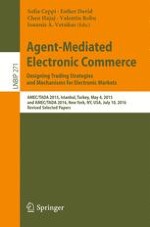This book constitutes revised selected papers from the 17th and 18th International Workshop on Agent-Mediated Electronic Commerce, AMEC TADA 2015 and 2016, which took place in Istanbul, Turkey, in May 2015, and in New York City, USA, in July 2016.
The 10 papers presented in this volume were carefully reviewed and selected for inclusion in the book. Both workshops aim to present a cross-section of the state of the art in automated electronic markets and encourage theoretical and empirical work that deals with both the individual agent level as well as the system level. Given the breadth of research topics in this field, the range of topics addressed in these papers is correspondingly broad. They range from papers that study theoretical issues, related to the design of interaction protocols and marketplaces, to the design and analysis of automated trading strategies used by individual agents - which are often developed as part of an entry to one of the tracks of the Trading Agents Competition.
